Kangaroo vs Wallaby
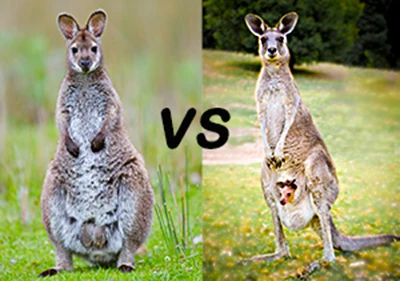
Photo: Wallaby vs Kangaroo
The main difference between wallabies and kangaroos is that wallabies are smaller than kangaroos, have shorter hind legs, often have brighter, more varied fur, and sometimes have distinct facial markings. Wallabies also live in forests, while kangaroos live on open plains. However, they are both hoping marsupials native to Australia and belong to the animal group Macropodidae. The four largest members of this group are called kangaroos. The rest are called wallabies. Wallabies are typically more solitary or live in smaller groups. Kangaroos, on the other hand, often live in larger groups called "mobs" and are more social. However, to confuse things a bit further, their sizes may overlap.
Physical Differences Between Wallaby and Kangaroo
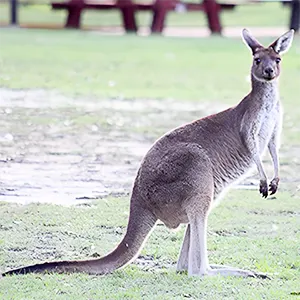
Photo: Kangaroo
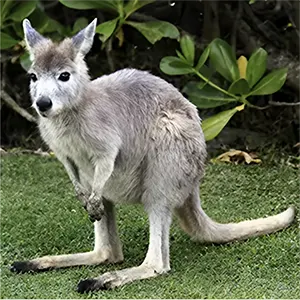
Photo: Wallaby
• Body Size: Kangaroos are significantly larger than wallabies. The largest kangaroo species, the Red Kangaroo, can reach up to 1.8 meters in height and weigh as much as 90 kilograms. In contrast, the largest wallaby, the Black Wallaroo, grows to about 1.2 meters and weighs up to 27 kilograms.
• Legs: Kangaroos have long, powerful hind legs designed for speed and for covering vast distances in open plains. Wallabies, adapted for life in dense forests, have shorter legs built for agility rather than speed.
• Teeth: Wallabies have flat molars suited for chewing leaves, while kangaroos have more pronounced front teeth and ridged molars designed for cutting grass. Additionally, wallabies retain their premolars, whereas kangaroos shed theirs as they grow.
Fur—Kangaroos have shorter fur with more muted colours, typically grey or red/orange in the case of the red kangaroo. Wallabies are slightly furrier than kangaroos and are more colourful, with two to three colour coats.
Wallaby vs Kangaroo - Habitat Differences
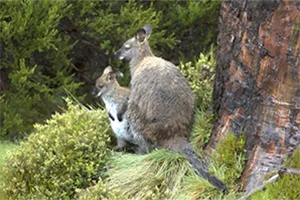
Wallaby Habitat
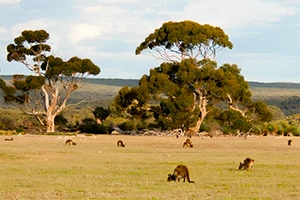
Kangaroo Habitat
• Wallabies prefer dense forests, rocky outcrops, and rugged terrain, where their agility helps them navigate obstacles. Very few wallabies live in dry, arid environments.
• Kangaroos thrive in open grasslands and savannah in temperate to hot climates. They use their long, efficient legs to travel across vast distances.
Wallaby vs Kangaroo - Diet & Feeding Behaviour
• Wallabies are browsers, primarily feeding on leaves, ferns, moss, flowers, and occasionally insects.
• Kangaroos are grazers, with a diet that consists mainly of grass, though some species, like the Red Kangaroo, also consume leaves and shrubs.
Both wallabies and kangaroos prefer to feed at night but also graze early in the morning and late evening when it's cool. They rest in the shade during the heat of the day.
Wallaby vs Kangaroo - Social Behaviour
• Kangaroos are more social and often found in large groups called “mobs”, which offer protection from predators.
• Wallabies tend to be more solitary or live in small family groups, avoiding large congregations.
Can Kangaroos and Wallabies Mate?
In the wild, kangaroos and wallabies do not interbreed. However, human attempts to cross breed them have resulted in unsuccessful or sterile offspring, meaning that they are genetically distinct enough to prevent natural hybridization.
Wallabies, Kangaroos, and Wallaroos?
To add to the confusion, there is also an intermediate group called wallaroos, which are sized between kangaroos and wallabies. Despite this distinction, wallaroos are often simply referred to as wallabies. Additionally, some animals may not fit neatly into these categories. For example, the Musky Rat-kangaroo is a tiny species classified as a wallaby despite having “kangaroo” in its name.
Conclusion
Kangaroos and wallabies share a common ancestry but have evolved to thrive in different environments. Kangaroos are larger, built for speed, and live in open spaces, while wallabies are smaller, more agile, and prefer forested or rocky landscapes. Whether bounding across the Outback or nimbly navigating the undergrowth, both of these marsupials are uniquely adapted to their habitats, making them some of Australia’s most remarkable creatures.